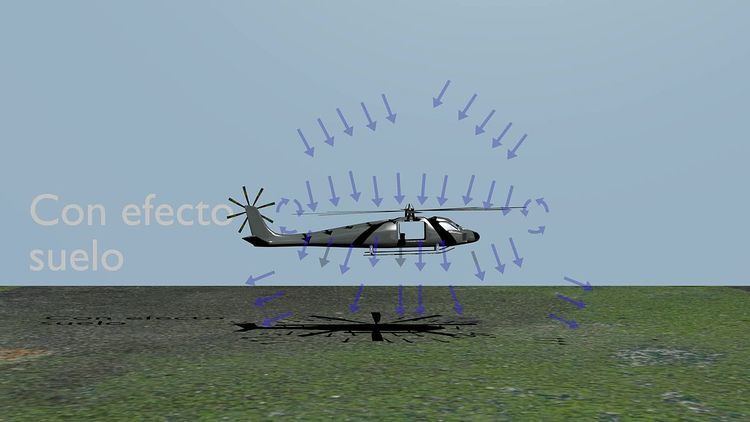 | ||
In fixed-wing aircraft, ground effect is the increased lift (force) and decreased aerodynamic drag that an aircraft's wings generate when they are close to a fixed surface. When landing, ground effect can give the pilot the feeling that the aircraft is "floating". When taking off, ground effect may temporarily reduce the stall speed. The pilot can then fly just above the runway while the aircraft accelerates in ground effect until a safe climb speed is reached.
Contents
Principle of ground effect
When an aircraft flies at a ground level approximately at or below the length of the aircraft's wingspan or helicopter's rotor diameter, there occurs, depending on airfoil and aircraft design, an often noticeable ground effect. This is caused primarily by the ground interrupting the wingtip vortices and downwash behind the wing. When a wing is flown very close to the ground, wingtip vortices are unable to form effectively due to the obstruction of the ground. The result is lower induced drag, which increases the speed and lift of the aircraft.
A wing generates lift by deflecting the oncoming airmass (relative wind) downward. The deflected or 'turned" flow of air creates a resultant force on the wing in the opposite direction (Newton's 3rd law). The resultant force is identified as lift. Flying close to a surface increases air pressure on the lower wing surface, nicknamed the "ram" or "cushion" effect, and thereby improves the aircraft lift-to-drag ratio. The lower/nearer the wing is with regards to the ground, the more pronounced the ground effect becomes. While in the ground effect, the wing requires a lower angle of attack to produce the same amount of lift. If the angle of attack and velocity remain constant, an increase in the lift coefficient ensues, which accounts for the "floating" effect. Ground effect also alters thrust versus velocity, where reduced induced drag requires less thrust in order to maintain the same velocity.
Low winged aircraft are more affected by ground effect than high wing aircraft. Due to the change in up-wash, down-wash, and wingtip vortices there may be errors in the airspeed system while in ground effect due to changes in the local pressure at the static source.
Another important issue regarding ground effect is that the makeup of the surface directly affects the intensity; this is to say that a concrete or other smooth hard surface will produce more effect than water or broken ground.
Ground effect vehicle
Many vehicles have a design that makes use of the wing in ground effect. Although all airplanes fly through ground effect at some point, craft that do so in a dedicated manner are designed in such a way that their wings are normally unable to take them into flight out of ground effect (free flight). Those that can fly out of ground effect are often capable of only a short distance take-off into free flight. Because of this, these craft are often licensed as ships rather than as aircraft. These specially designed craft may use delta wings, ekranoplan wings or tandem wings.
